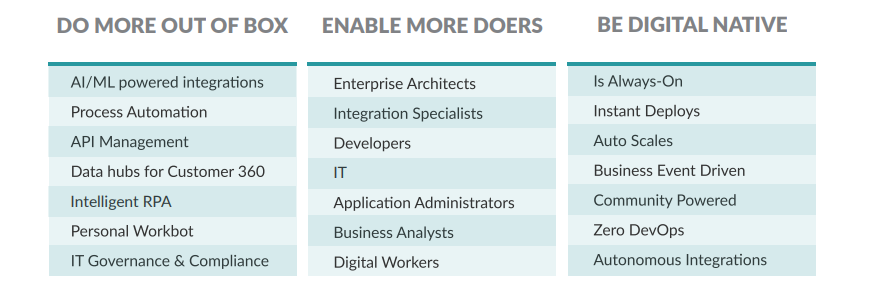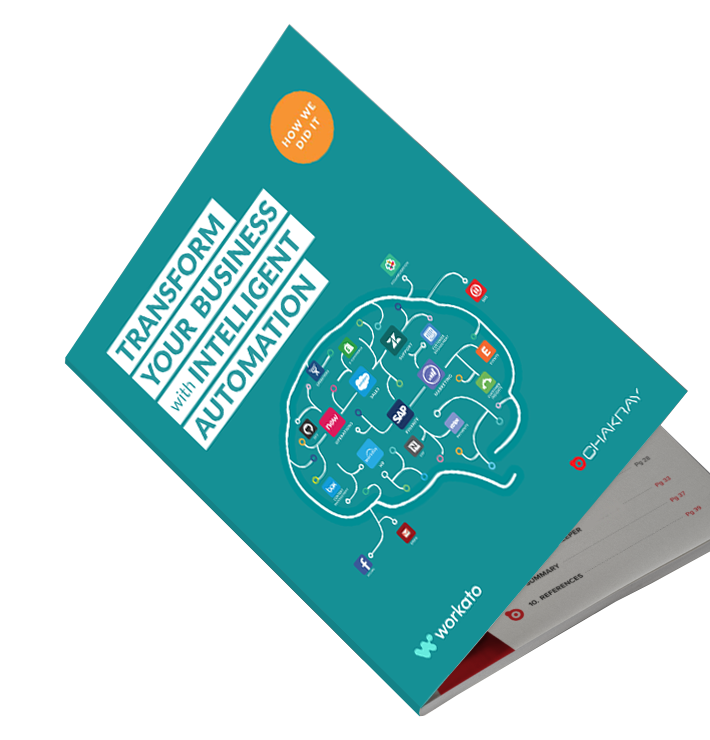The path to digital transformation has significant roadblocks, challenges and gaps due to the massive explosion of Clouds apps and APIs it has unleashed along the way, roadblocks that are technological as well as organizational.
It has become both the biggest opportunity and existential threat for enterprises to transform into dynamic digital companies in the mold of innovators like Amazon, Netflix and Walmart in order to avoid the fates of a Blockbuster, a Borders, or a Kmart. All of this has meant an incredibly high rate of change across the board for enterprise.
CHANGES IN DIGITAL TRANSFORMATION
Changes have occurred in the following areas:
- THE BUSINESS STRATEGY as new threats and opportunities emerge.
- THE NUMBER OF APPS and cloud, big data and AI technologies being adopted
- THE MARKETS and competitive landscape.
- THEIR OWN EMPLOYEE and customer expectations, which are set by the revolution that’s been happening in the consumer tech in their lives.
Such a high level of dynamism has put tremendous stresses on business and IT groups across the company to speed up the painfully slow transformation programs. There are two major issues holding back companies today which we will see below. Such a high level of dynamism has put tremendous stress on business and IT groups across the company to speed up the painfully slow transformation programs
CHALLENGES AND GAPS IN DIGITAL TRANSFORMATION
There are two major challenges and gaps holding back the digital transformation companies are currently facing:
1) TECHNOLOGY GAP
The first is a technology gap, a gap in the breadth of functional capabilities required to implement digital business initiatives, such as process automation, customer 360, machine learning and bots to automate personal work.
Workato, was the first first to be part of the team that created the very first integration platform in the late eighties and early nineties.
It was called The Information Bus and it was designed to be the software analog of a hardware bus with a similar goal of getting disparate, complex (in this case, software) components from different vendors to work together seamlessly.
This led to TIBCO and a wave of middleware technologies and public companies like Informatica, BEA, IBM, Webmethods, and Oracle and then to more cloudy versions of those with products like Mulesoft, Boomi, Snaplogic, and Jitterbit.
The landscape has significantly changed in the past ten years. SaaS (software as a service) has dramatically altered the software adoption curve by making business apps easy to use, buy and maintain.
As a result, software has become an integral part of every business – not just large enterprises – and businesses are adopting SaaS/Cloud and Mobile applications at a much more rapid pace.
According to Holger Mueller, VP of Constellation Research:
“Many integration tools on the market are struggling with digital transformation themselves.”
These traditional integration tools—which were created over a decade ago— are inadequate for both handling this level of dynamism and for supporting digital customer journeys and workflows that cut across business’ apps and extend into their customers’ and partners’ systems.
ISSUES: TECH GAP
There are 3 issues that stem from this technology gap:
- CUSTOMER DATA IS MORE FRAGMENTED THAN EVER.
Every company’s customer data is splintered across hundreds of apps which sprawl across their IT and business groups. This fragmentation means poor visibility of the organization’s customers, inconsistent or incorrect customer info stored in different places, and incomplete or irrelevant customer info in the hands of their workers. It also means the uncontrolled data sprawl increases business and compliance risks due to poor transparency and lack of governance around critical customer information. No matter how far the state of fragmentation at a company is, the result is the same: subpar or counterproductive digital engagement with customers, the antithesis of digital transformation.
- TODAY’S INTEGRATIONS ARE MORE DYNAMIC AND PERVASIVE.
BEFORE: Integrations were used only between a few departmental System-of-Record apps like ERP, CRM, marketing, customer support, HR, and ITSM. Once set up, no one expected these integrations to change much. If they required adjustment, it was difficult and required IT and specialists.
NOW: Integrations must also cover hundreds of Systems-of-Engagement (like Slack, Email, Twilio, Zoom, and social media), Systems-of-Insight (like Redshift, Tableau, and Splunk), and Productivity apps (like JIRA, the Google Suite, and Trello) across departments. Today the circumstances of integration in companies are drastically different.
- DIGITAL CUSTOMER JOURNEYS & EXPERIENCES REQUIRE MORE THAN INTEGRATION.
According to PwC, by 2020 the demand for an omnichannel customer experience will be amplified by the need for near perfect execution. To fulfill this expectation, companies need more than back-end integrations for a few big departmental apps. They need a platform that can: automate digital customer journeys for better cx, deliver smarter, faster process automation with AI and machine learning, empower employees to better serve customers by delivering them timely, relevant information via work bots.
2) SOCIAL GAP
The second of the digital transformation gaps is the social gap, in the form of the divide between companies and citizens.
True transformation requires that you harness the full power of your entire organization.
Enterprise-grade tools are accessible only by IT and developers, while the digital business initiatives are being driven by business users across the company.
Since IT is not able to keep up with all the integration requests from the business, it has resulted in a vicious cycle of rogue IT in departments leading to poor visibility, lack of governance, high corporate risk, and a huge divide between business and IT. IT and business teams using different tools, working at different speeds, on different wavelengths, for different purposes is the biggest obstacle to companies becoming dynamic digital businesses. Bi-modal IT (control OR productivity) is a Faustian bargain; your company needs both to succeed.
More than ever, businesses need an intelligent automation tool that bridges this divide, aligns the organization, and makes it viable for business users to create robust automations in collaboration with IT for governance, compliance, transparency, and security. Business users should also be able to operate these integrations themselves. An intelligent automation platform must be accessible to all and work differently, drive teaming and governance between business and IT, and leverage the power of the business community to execute faster and smarter. Specifically the below.
GOING DIGITAL REQUIRES ‘DIGITAL LITERACY’ FAR OUTSIDE OF IT.
Business users must be able to automate workflows themselves or maintain those created by IT so they can make ongoing changes as needed in a governed, secure manner.
This isn’t possible with most tools.
“Citizen developers” and “citizen integrators” are among the most misused terms when it comes to integration platforms. You cannot give these “Citizen” tools to the average (or even above average) Salesforce admin, let alone a marketing analyst or a financial analyst.
Application administrators and analysts are required to integrate the apps they manage and are responsible for process improvement within their groups. While they know their apps, they do not know technical concepts like XML, XSLT, REST, SOAP, or deployments that traditional tools require them to know are far outside of their comfort zone. Intelligent automation tools must present an entirely different, business-friendly level of abstraction around these technologies as well as a rational, humanized API-level interface so an average business user can create workflows and maintain them.
A digital native approach means automating the automations to recover quickly from data or process errors. It supports an intuitive ability to review errors, fix the data or process, and re-run them. An intelligent automation platform lets you set custom recovery and notification policies to proactively detect and resolve the inevitable data, process, or other exceptions.
MODERN DIGITAL BUSINESS PLATFORMS MUST WORK DIFFERENTLY
You don’t go to your Instagram account and “provision” it for certain number of photos, videos, shares or comments; you don’t think about setting it up for “peak loads”; you don’t configure (and are not forced to pay for!) “high availability” so the service is Always On for you; and you certainly don’t operate the sharing of your posts and feedback! However, today’s cloud iPaaS and ESB tools work exactly this way.
This is incredibly backwards! After creating popular consumer products for years at Qik and Skype, it became super clear that an intelligent automation tool—whose goal is enabling speed, agility, and dynamism with beautiful experiences—must be based on a digital native architecture and operate very differently in 2017. It must work more like an Instagram account (where everything but taking the pictures is automatic) than like a camcorder, where you have to do literally everything
The traditional approach to integrations is that of a lone-wolf: typically an integration specialist thinks up integrations from scratch, implements them, deploys them from scratch, and then hands them over to business or IT.
This is also how developers used to work until GitHub and the open source movement came along. Now developers are vastly more productive by collaborating and leveraging the work that thousands of others have done.
GitHub solves not just the productivity problem around writing code; it also solves the thinking problem around designing what code to write! Similarly, intelligent automation for digital businesses demands a collaborative community of business users around automations within your company, across companies and industries, i.e. a GitHub for Automations.
Community-powered integrations are vetted and proven out-of-the-box and are at least 10x faster time to value than traditional integrations.
HOW INTELLIGENT AUTOMATION HELPS BRIDGE THE DIGITAL TRANSFORMATION GAPS
A new paradigm, Intelligent Automation, and supporting tooling based on a digital native approach is required to address both the technology and social gaps to unlock the power of digital transformation in your business.
The tech gap and social gap show the hard challenges from a technology and business/it standpoint that stand in the way of truly transforming your business.
Organisations employing intelligent automation can achieve a level of connectivity that is impossible without solving the tech and social gaps.

Figure 1. Do more, enable more, be digital.
CONCLUSION
As we can see, while fragmented data and the digital business technology gap are major hurdles for transformation, perhaps the most important challenge to overcome is the social gap or divide between business and IT. That’s when automation comes into place, to fix the above. If you need to overcome those challenges and you need help in your organization, you have landed on the right article, do not hesitate to contact us and one of our professionals will contact you!








